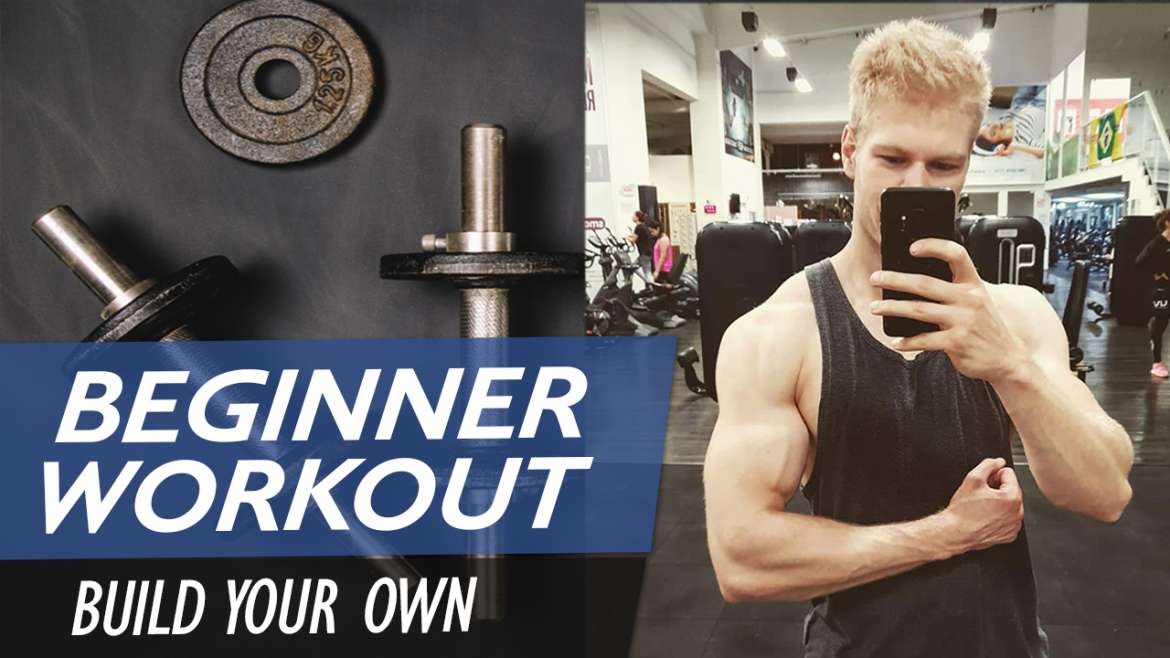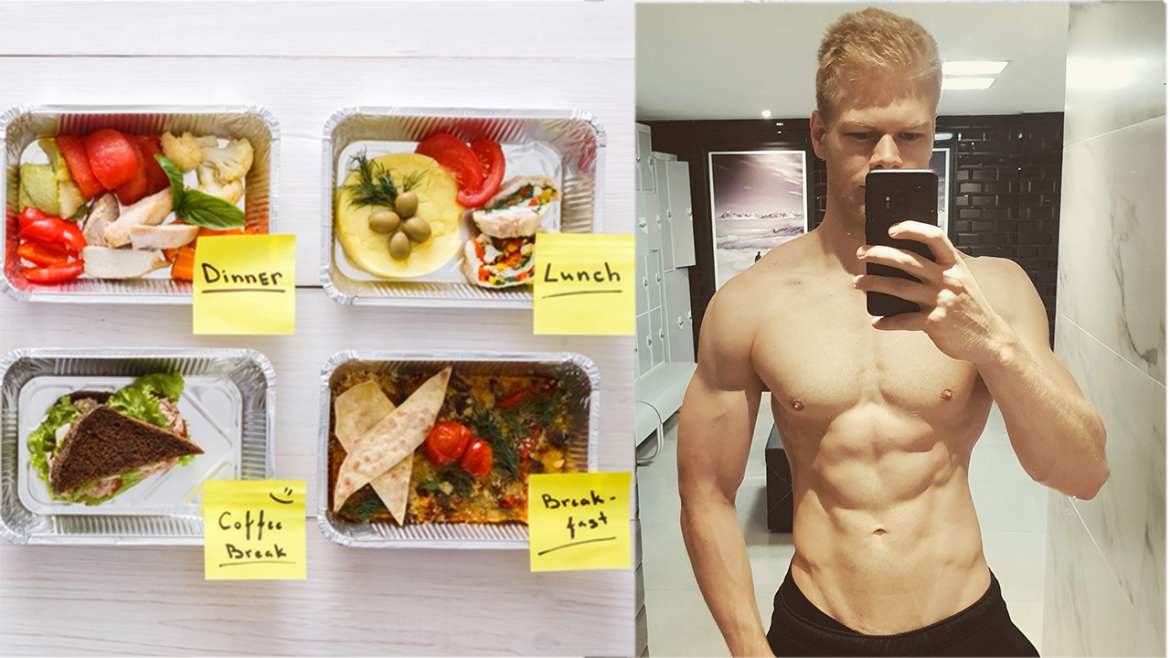Coming up with the right workout plan might be a bit intimidating, but let me tell you that it is a lot easier than you think. In this post, I will show you how to design the perfect workout for strength and muscle building. I will take you through the process step by step and at the end you will also get a sample workout to get going right away.
Whether you are doing this for yourself or someone else as a fitness coach, the principles will always be the same and if you follow this step-by-step process it can also be fun to give a workout your personal touch.
Step #1: Setting the right goals
One of the first questions you should ask yourself or you client is, “what do you want to achieve with this workout?”
Most beginners will name things like „build muscle“, „look better naked“ or „become stronger“ it makes sense to get a bit more specific than that. Make sure you know what the primary focus is.
Do you want to build muscle as fast as possible?
Or maybe you prefer to focus on strength?
Or maybe even muscular endurance?
It also makes sense to if there is a specific body part that needs special attention. This will help later with exercise selection. If there isn’t then don’t worry about it and just assume that all muscles need to be targeted equally.
Step #2: Deciding on training frequency
The next step is to determine how often you or your client can work out per week. The ideal training frequency is always open for debate and you will get thousands of different answer if you looked online.
For beginners it makes sense to go with 3 to maximum 4 workouts per week. This makes sure to work the muscle enough to cause hypertrophy but to not overwork it either.
Many beginners will want to do more than that, because they think more workouts mean faster muscle growth. The problem is that muscles don’t grow in the gym but afterwards when they have time to rest.
If you don’t give them the necessary time to recover, you can quickly burn out especially if you aren’t used to training with heavy weights.
Step #3: Exercise selection
The sheer amount of possible exercises can make it seem hard to select the right ones. However, when focusing solely on effectiveness, compound exercises are always the way to go.
The four most common compound exercises you will find in the gym are the squat, bench press, deadlift and the overhead press. All of them should be included in a good beginner workout.
That’s because they utilize multiple joints and are usually performed with free weights instead of machines. Unlike isolation exercises, compound movements work several muscles at once. This will give you the best results measured by the time you spend training.
Always start your gym routine with compound exercises that target whatever muscle group(s) you are training that day. Not only will you achieve maximal muscle recruitment, but more nervous system activation and a better overall stimulus.
To round up your workout you also want to include some assistance exercises. Here are a few good examples:
Assistance Exercises:
For the upper body you can include: pull-ups and rows for the back, incline or decline bench press for the chest and side or front raises for the shoulders
For the lower body you can include: lunges, hack squats, Bulgarian split squats or good mornings
Isolation Exercises:
And lastly, you can include one or two isolation exercises at the end of your workout. These would be things like bicep curls, triceps push-downs, leg extension or calf raises.
Like I said before, these are just examples and there are countless exercises you or your client can do. You will see that over time everyone will find their favorite exercises and they will adjust their workouts accordingly.
Step #3: Choosing your weight, sets and reps
Now that you know your exercises, how many sets and reps and how much weight should you do?
This will usually depend on your goals. Let’s start with reps:
How Many Reps Should You Do?
As a general rule of thumb the fewer reps you do the more weight you will be able to lift and the more you will train for strength. The more increase your number of reps the less weight you will be able to lift and the more you train for endurance. Training optimal muscle growth falls somewhere in the middle.
To put this into numbers, anything below 4 reps will be mostly strength, anything between 4-12 reps will be mostly muscle growth and anything above 12 will be more and more endurance.
As a beginner it’s usually best to do around 10-12 reps during your first few weeks. That way your weight is light enough so you can get a feeling for the movements of the exercises.
Once the movements are learned and your goal is muscle growth, a range of 6 – 8 reps for the four main lifts is probably best. At least that’s my experience training beginners.
How Many Sets Should You Do?
Beginners will need only a low amount of volume to see results. Volume can be defined as sets x reps x resistance. To keep your volume low shoot for a total of 15-20 sets per workout.
Split these sets up into 4 to 5 exercises and you are good to go. This means around 3-4 working sets for each exercise. Keep in mind that this doesn’t include your warm-up sets, which go on top of that figure.
Don’t worry if you are getting confused at this point, I will show you a sample workout at the end of this post.
Another variable we need to address is weight.
How heavy should you lift?
First of all, don’t go to failure. You want to train hard but not go all out. As a good rule of thumb, you want to stop 1 – 2 reps short of failure on each set. This is a good starting point for beginners and makes sure you don’t risk injuries.
What about rest between sets?
The more you train for strength, so the heavier you lift, the longer your breaks should be. The more you train for endurance the shorter your breaks should be.
Most beginners will do fine with 2 minutes of rest between their sets, but you have to figure out the right value for yourself. Some people seem to have no problems with shorter rest times between sets, while others just need an extra 30 seconds on top of what’s normal.
Step #4: Keep progressing
At this point we are almost done. Before I show you the sample workout, you need to understand one thing. In order to build muscle long term, you have to give the body an incentive to do so.
The most effective incentive is progressive overload. This means you should constantly strive to lift more weight.
Sometimes you’ll be able to add five pounds to your bench press, week after week. Sometimes it will be none for several consecutive workouts. That’s fine as long as an overall trend is noticeable.
Beginners should take advantage of their first few months, because this is when their body will quickly adapt to the new stress placed on their muscles and build strength and size extremely fast.
Sample Workout
Let’s now have a look at a sample workout that fits all these criteria. Let’s assume you or your client train 3 times per week. We will therefore divide the workouts as follows:
Schedule Week 1:
Monday – Full Body Workout 1
Tuesday – Rest
Wednesday – Full Body Workout 2
Thursday – Rest
Friday – Full Body Workout 1
Saturday – Rest
Sunday –Rest
Schedule Week 2:
Monday – Full Body Workout 2
Tuesday – Rest
Wednesday – Full Body Workout 1
Thursday – Rest
Friday – Full Body Workout 2
Saturday – Rest
Sunday –Rest
Schedule Week 3: Repeat Week 1
As you can see there are 2 workouts, Full Body Workout 1 and 2 and all you do is alternate between them.
How To Train During The First Month
During the first month, where I just want you to get a hang of the exercise movements we will actually a bit less than the 15 recommended reps and just focus on main lifts. Here is what this looks like.
Full Body Workout 1:
Squats: 3 Sets of 8 – 10 Reps
Bench Press: 3 Sets of 8 – 10 Reps
Bent Over Barbell Row: 3 Sets of 8 – 10 Reps
Full Body Workout 2:
Deadlift: 3 Sets of 8 – 10 Reps
Pull-Ups: 3 Sets of 8 – 10 Reps
Military Press: 3 Sets of 8 – 10 Reps
Rest: 2 – 3 minutes between sets
Changes After The First Month
Once the movements are understood, which generally happens after about 4 weeks, you should make the following changes to the workout.
1. Add 1 additional set to each exercise
2. Add 1 isolation exercise with 4 sets at the end of the workout.
3. Lower the rep range from 8 – 10 to 6 – 8 for the first three compound lifts in each workout. Like I said before, in my experience this is the ideal rep range for most beginners.
Your workout will then look something like this.
Full Body Workout 1:
Squats: 4 Sets of 6 – 8 Reps
Bench Press: 4 Sets of 6 – 8 Reps
Bent Over Barbell Row: 4 Sets of 6 – 8 Reps
Bicep Curls: 4 Sets of 8 – 10 Reps
Full Body Workout 2:
Deadlift: 4 Sets of 6 – 8 Reps
Pull-Ups: 4 Sets of 6 – 8 Reps
Military Press: 4 Sets of 6 – 8 Reps
Tricep Pushdowns: 4 Sets of 8 – 10 Reps
Rest: 2 – 3 minutes between sets
And there you have it.
That’s how you design your very own workout program from scratch. If you want you can go with the one above and get started today. Or you can adjust it to your personal preferences and training style.
Have fun 🙂



